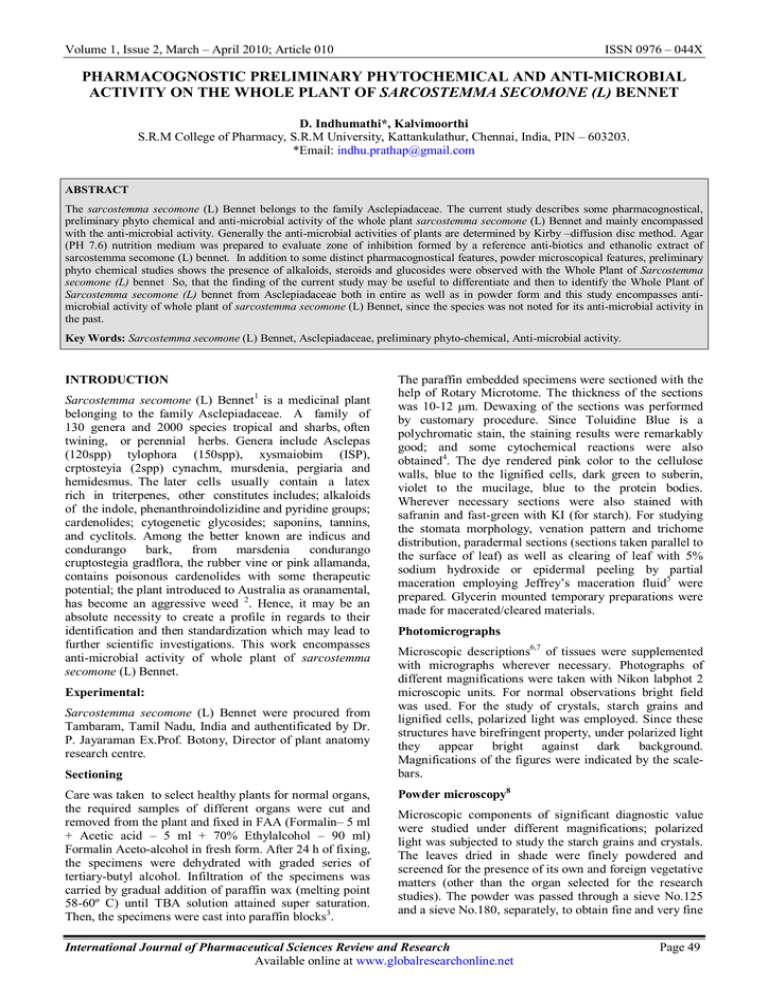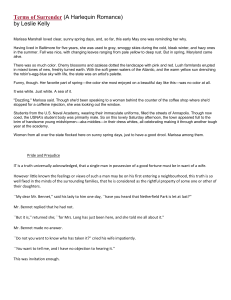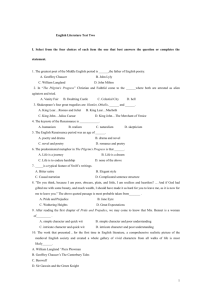Document 13308017
advertisement

Volume 1, Issue 2, March – April 2010; Article 010 ISSN 0976 – 044X PHARMACOGNOSTIC PRELIMINARY PHYTOCHEMICAL AND ANTI-MICROBIAL ACTIVITY ON THE WHOLE PLANT OF SARCOSTEMMA SECOMONE (L) BENNET D. Indhumathi*, Kalvimoorthi S.R.M College of Pharmacy, S.R.M University, Kattankulathur, Chennai, India, PIN – 603203. *Email: indhu.prathap@gmail.com ABSTRACT The sarcostemma secomone (L) Bennet belongs to the family Asclepiadaceae. The current study describes some pharmacognostical, preliminary phyto chemical and anti-microbial activity of the whole plant sarcostemma secomone (L) Bennet and mainly encompassed with the anti-microbial activity. Generally the anti-microbial activities of plants are determined by Kirby –diffusion disc method. Agar (PH 7.6) nutrition medium was prepared to evaluate zone of inhibition formed by a reference anti-biotics and ethanolic extract of sarcostemma secomone (L) bennet. In addition to some distinct pharmacognostical features, powder microscopical features, preliminary phyto chemical studies shows the presence of alkaloids, steroids and glucosides were observed with the Whole Plant of Sarcostemma secomone (L) bennet So, that the finding of the current study may be useful to differentiate and then to identify the Whole Plant of Sarcostemma secomone (L) bennet from Asclepiadaceae both in entire as well as in powder form and this study encompasses antimicrobial activity of whole plant of sarcostemma secomone (L) Bennet, since the species was not noted for its anti-microbial activity in the past. Key Words: Sarcostemma secomone (L) Bennet, Asclepiadaceae, preliminary phyto-chemical, Anti-microbial activity. INTRODUCTION 1 Sarcostemma secomone (L) Bennet is a medicinal plant belonging to the family Asclepiadaceae. A family of 130 genera and 2000 species tropical and sharbs, often twining, or perennial herbs. Genera include Asclepas (120spp) tylophora (150spp), xysmaiobim (ISP), crptosteyia (2spp) cynachm, mursdenia, pergiaria and hemidesmus. The later cells usually contain a latex rich in triterpenes, other constitutes includes; alkaloids of the indole, phenanthroindolizidine and pyridine groups; cardenolides; cytogenetic glycosides; saponins, tannins, and cyclitols. Among the better known are indicus and condurango bark, from marsdenia condurango cruptostegia gradflora, the rubber vine or pink allamanda, contains poisonous cardenolides with some therapeutic potential; the plant introduced to Australia as oranamental, has become an aggressive weed 2. Hence, it may be an absolute necessity to create a profile in regards to their identification and then standardization which may lead to further scientific investigations. This work encompasses anti-microbial activity of whole plant of sarcostemma secomone (L) Bennet. Experimental: Sarcostemma secomone (L) Bennet were procured from Tambaram, Tamil Nadu, India and authentificated by Dr. P. Jayaraman Ex.Prof. Botony, Director of plant anatomy research centre. Sectioning Care was taken to select healthy plants for normal organs, the required samples of different organs were cut and removed from the plant and fixed in FAA (Formalin– 5 ml + Acetic acid – 5 ml + 70% Ethylalcohol – 90 ml) Formalin Aceto-alcohol in fresh form. After 24 h of fixing, the specimens were dehydrated with graded series of tertiary-butyl alcohol. Infiltration of the specimens was carried by gradual addition of paraffin wax (melting point 58-60º C) until TBA solution attained super saturation. Then, the specimens were cast into paraffin blocks3. The paraffin embedded specimens were sectioned with the help of Rotary Microtome. The thickness of the sections was 10-12 µm. Dewaxing of the sections was performed by customary procedure. Since Toluidine Blue is a polychromatic stain, the staining results were remarkably good; and some cytochemical reactions were also obtained4. The dye rendered pink color to the cellulose walls, blue to the lignified cells, dark green to suberin, violet to the mucilage, blue to the protein bodies. Wherever necessary sections were also stained with safranin and fast-green with KI (for starch). For studying the stomata morphology, venation pattern and trichome distribution, paradermal sections (sections taken parallel to the surface of leaf) as well as clearing of leaf with 5% sodium hydroxide or epidermal peeling by partial maceration employing Jeffrey’s maceration fluid5 were prepared. Glycerin mounted temporary preparations were made for macerated/cleared materials. Photomicrographs Microscopic descriptions6,7 of tissues were supplemented with micrographs wherever necessary. Photographs of different magnifications were taken with Nikon labphot 2 microscopic units. For normal observations bright field was used. For the study of crystals, starch grains and lignified cells, polarized light was employed. Since these structures have birefringent property, under polarized light they appear bright against dark background. Magnifications of the figures were indicated by the scalebars. Powder microscopy8 Microscopic components of significant diagnostic value were studied under different magnifications; polarized light was subjected to study the starch grains and crystals. The leaves dried in shade were finely powdered and screened for the presence of its own and foreign vegetative matters (other than the organ selected for the research studies). The powder was passed through a sieve No.125 and a sieve No.180, separately, to obtain fine and very fine International Journal of Pharmaceutical Sciences Review and Research Available online at www.globalresearchonline.net Page 49 Volume 1, Issue 2, March – April 2010; Article 010 ISSN 0976 – 044X powder respectively and then subjected for microscopic examination. The sample was treated with following reagents and studied for their components of diagnostic value (50% glycerin as temporary mountant; phloroglucinol (2% W/V) in ethanol (90%) and conc. HCl (1:1) for lignin; 5% W/V of alcoholic ferric chloride for phenolic compounds; 2% Iodine solution for starch grains; and Ruthenium red (0.08%) in 10% lead acetate for mucilage). Preliminary phyto-chemical screening9 The leaves were dried in shade at room temperature and screened for the presence of foreign matter. The leaves were ground to a moderately coarse powder in a mechanical grinder. About 450g of the powder was extracted successively with ethanol (95%) using soxhlet apparatus. The extraction with solvent was carried for 24h. Finally, the marc left was extracted with water by digesting on a boiling water bath. The extraction was continued till a few drops of the last portion of the extract left no residue on drying. The extracts were taken in a tarred porcelain dishes and evaporated to dryness on a water bath and dried at 105º C to a constant weight. The percentage extractives were calculated with reference to air dried drug. Microbial studies Kirby-baner diffusion disc method10 is commonly employed for antibiotic sensitivity test. The sterile mullerHinton agar (Ph 7.3) plates were prepared with depth of 4mm. The minimum inhibitory concentration of control Anti-biotic, three reference samples respectively named as A, B, C and ethanolic extract of sarcostemma secomone (L) Bennet named as D. The discs were prepared11 by whattman’s filter paper, labeled as A, B, C and D and dipped into minimum inhibitory concentration solution with respective labels after 30mins, dried in an incubator to remove excess of moisture from the surface. 5-6 colonies selected and inoculated the colonies into agar broth with the help of wire loop. One sensitivity discs removed from their respective vials with the help of flamed forceps and carefully placed them in the plate, at least 24mm away from the edge equal distance of placement to avoid the over lapping of the zones of inhibition. The plates were incubated at 37oC for 16-18 hours12. Agar (PH7.6) nutrition medium was prepared to evaluate zone of inhibition formed by a reference antibiotics and ethanolic extract of sarcostemma secomone (L) bennet. RESULTS AND DISCUSSION Fresh leaves appear greenish in adaxial side and pale green on abaxial side (Fig1.3); dried leaves exhibit pale brown above and greenish orange below; petiolate; leaves appear with truncate base, and shortly mucronate apex; veination prominent below and flat above; entire margin, petiole 0.5 – 1 cm long (Fig1.2). Flowers are very conspicuous by aggregation dark purple inside and whitish outside, bract, decidous; bracteole prominent, calyx; cup shaped, lobes equal, ovate, inlericate; corolla-corollatube rotate to angulate, coroolalobes triangular, united at middle half, ciliate, valuate, pollinia pendulous (Fig.1.1). The leaf has fair thick lamina and less distinct midrib; the midrib is plain convex with flat adaxial side and convex abaxial side. It is 700m thick in vertical plane. It consists of a thin adaxial epidermal layer of small thin walled cells. The ground tissue of the abaxial side consists of large thin walled angular parenchyma. The vascular bundle is single, more or less flat and has a horizontal band of xylem element and phloem both on the adaxial and abaxial side (Fig 3.1). The xylem elements are thick walled, angular and compactly arranged in parallel rows. Phloem elements are in small nests of five to ten cells (Fig 3.2). Calcium oxalate crystals are sparsely seen in the abaxial ground tissue. The crystals are clusters (Fig 3.3.) The lamina is smooth dorsiventral and mesomorphic. It is 400m thick in middle part and 180m thick along the margin. The adaxial epidermis is fairly thick along the margin. The epidermis is about 30m thick. The abaxial epidermis is thin and consist of narrowly rectangular thin walled cells (Fig 2.2). The mesophyll tissue consist of a wide zone of palisade tissue and a narrow zone of spongy mesophyll tissue. The palisade tissue is 200m in height and has two layers of narrow cylindrical compact cells. The lateral veins have small collateral vascular bundle with parenchymatous bundle sheath, adaxial and abaxial extensions (Fig 2.3). The adaxial epidermis is apostomatic. The cells are polygonal with straight, thin, anticlinical walls (Fig 4.1). Abaxial epidemis is stomatiferous, the stomata are mostly paracytic with two wing like subsidiary cells with one radially rectangular unshaped. The ground cells are elliptical measuring 20x15m. The epidermal cells are large, polygonal with straight or slightly wavy thin anticline walls. Stomular frequency -50/mm2 (Fig 4.2). The lateral veins are fairly thick; the veinlets are thin International Journal of Pharmaceutical Sciences Review and Research Available online at www.globalresearchonline.net Page 50 Volume 1, Issue 2, March – April 2010; Article 010 and profusely branched. The vein islets are distinct, wide and variable in outline. The vein terminations are also distinct, wide and variable in outline. The vein ISSN 0976 – 044X terminations are also distinct. They are either simple or branched, twice or thrice (Fig 5.1) (Fig 5.2). International Journal of Pharmaceutical Sciences Review and Research Available online at www.globalresearchonline.net Page 51 Volume 1, Issue 2, March – April 2010; Article 010 International Journal of Pharmaceutical Sciences Review and Research Available online at www.globalresearchonline.net ISSN 0976 – 044X Page 52 Volume 1, Issue 2, March – April 2010; Article 010 Powder characteristics The powder was pale green in colour; with no any specific odour; slightly bitter; smooth and slippery in texture. The abaxial epidermis has abundant stomata, which are either cyclocytic, paracytic or anomocytic. The ground cells are elliptical measuring 20m long and 15m wide. The epidermal cells are polygonal and rectangular with thin, straight, anticlinal walls. (Fig 6.1, 6.2) The adaxial epidermis has a few stomata mostly near the veins. The stomata are paracyric or cyclocytic. The epidermal cells are polyhyderal with five to six sides. The anticlinal walls are straight and thick (Fig 7.1) (Fig 7.2). The lactifers are latex secreting structure, they are long, narrow, branched and septale. (Fig 8.1) (Fig 8.2). The lactifiers has dense, lobed, solid particles, 22m thick. Non-Glandular, Epidermal trichomes are sparingly seen in the powder. The trichomes are multicellular, uniseriate and unbranched. The cells are broadly rectangular; they have granular cuticle surface. The trichome is 240m long and 20m thick (Fig 8.3) Preliminary phytochemical analysis The Ethanonic Extract of sarcostemma secomone (L) Bennet whole plant analysed systematically for the different chemical groups to assess one active constituents present and nature of polarity of the constituents like alkaloids, steroids, corbohydates, fixed oils, Tannins, phenolic compounds, proteins, glycosides. The ethanolic extract showed the presence of phytoconstituents such as alkaloids, tannins and ISSN 0976 – 044X glucosides. The ethanolic extract does not contain such a phyto constituents like carbohydrates and proteins (Table-1). Microbial studies The Anti-microbial activity shows the resistant action against gram negative bacteria and intermediate action against gram positive bacteria (Table–2). International Journal of Pharmaceutical Sciences Review and Research Available online at www.globalresearchonline.net Page 53 Volume 1, Issue 2, March – April 2010; Article 010 ISSN 0976 – 044X Table 1. Data showing the qualitative chemical tests of Ethanolic Extract of Sarcostemma secomone (L) bennet. Tests Ethanolic Extract 1. Alkaloids a. Mayer’s reagent b. Dragendroff’s reagent c. Hager’s reagent 2. Steroids a. Liebermann’s burchard test b. Salkowski test 3. Carbohydrates a. Benedict’s reagent b. Fehling’s reagent 4. Tannins 5. Glycosides a. Steroidal glycosides b. Glycosides 6. Terpenoids 7. Proteins a. Biurette test b. Millon’s test + Test positive, – Test negative + + + + + + - Table 2. Data showing the antimicrobial activity of ethanolic extract of Sarcostemma Secomone (L) Bennet. Drug Name of the bacteria D Control anti-bacteria (penicilline) A B C 0.7 1.4 1.1 0.7 2.2 0.7 0.6 No zone 0.8 Gram positive Bacteria 1. Staphylococcus aureus 2. Bacillus subtilis No zone Gram negative Bacteria 1. E.coli 1.1 1.5 0.6 1.7 3.1 2. Salmonella typhi 0.6 1.3 1.1 0.9 2.7 A, B, C-Reference samples, D-Ethanolic extract of Sarcostemma Secomone(L)Bennet. (Test sample) CONCLUSION In addition to from some distinct pharmacognostical features, powder microscopical features, preliminary phyto chemical studies shows the presence of Alkaloids, steroids and glucosides were observed with the whole Plant of Sarcostemma secomone (L) bennet. Kirby-baner diffusion disc method shows the presence of antibiotic activity. The anti-microbial activity shows the resistant action against gram negative bacteria and intermediate action against gram positive bacteria. So, that the finding of the current study may be useful to differentiate and then to identify the whole Plant of Sarcostemma secomone (L) bennet from Asclepiadaceae both in entire as well as in powder form. Hence it can be concluded, that this study encompasses anti-microbial activity of whole plant of Sarcostemma secomone (L) Bennet, since the species was not noted for its anti-microbial activity in the past. REFERENCES 1. William Charles Evans., Trease and evans pharmacognosy, Harcourt Brace & company Asia PTE LTD, Singapore, 46-47. International Journal of Pharmaceutical Sciences Review and Research Available online at www.globalresearchonline.net Page 54 Volume 1, Issue 2, March – April 2010; Article 010 ISSN 0976 – 044X 2. Rout S.D, Panda T, Mishra N., Ethno-Med, 2009, 27-32. 3(1), 8. O’Brien T.P, Feder N and Cull M.E., Protoplasma, 59, 1964, 364 –373. 3. Khandelwal K R, Practical pharmacognosy Techniques and Experiments,16, Nirali Prakashan, India, 2006, 14-165. 9. Easu K., Plant Anatomy, John Wiley and Sons, New York, 1964, 767. 4. Lala P. K., Practical pharmacognosy, 1, Lina Guha Publication, India1981, 135-155. 5. Johansen, D.A., Plant Microtechnique, Mc Graw Hill Book Co, New York, 1940, 523. 6. Sass J.E, Elements of Botanical Micro-technique, Mc Graw Hill Book Co, New York, 1940, 222. 7. Henry A.N, Kumari G.R. and Chitra V, Flora of Tamilnadu, Botanical Survey of India, Southern Circle, Coimbatore. 10. Harbone J.B., Phytochemical methods, 3rd ed, Chapman and Hall, London, 2005, 49-52. 11. Tonia Rabe and Johannes van staden., Journal of Ethnopharmacology., 56(1), Mar-1997, 81-87. 12. McGaw L.J, Jager A.K and Van Staden J, Journal of Ethnopharmacology, 72 (1-2), Sep-2000, 247-263. 13. Jawetz, Melnick and Adelberg’s,, Medical Microbiology, 24th Edition , MC Graw-Hill Medical Publishers, New york., 2007, 167-169. ************* International Journal of Pharmaceutical Sciences Review and Research Available online at www.globalresearchonline.net Page 55





